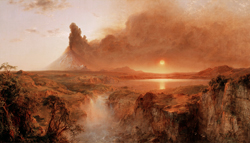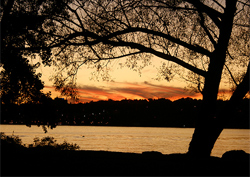They call it the Hudson River because of Henry Hudson, the son of a bitch who explored its waters on a mission for the Dutch East India Company. That was 400 years ago, in 1609. Sitting on the upstairs deck of my sister’s house in New Baltimore, 400 years doesn’t seem like much. The water is swirling in the thin late-summer light. A thousand years could have passed just now. A million creatures could have died and been born along the shores. A hawk bullets down and shrieks at the water, “Give me fish.” The water doesn’t care. A barge ambles into the scene, all red rust and splashy wake. Huge. Bigger than seems possible. The river and the trees and the houses say one scale, the barge says another. But the river holds it. The river passes it along.
Henry Hudson spent most of his time looking for the Northwest Passage. He wanted to get through all the pesky land and make it from one ocean (the Atlantic) to another (the Pacific). Such a passage doesn’t really exist. To get around North America you’ve got to do just that — go up and around the thing altogether. But Henry didn’t know that. He hoped the river was the ticket, west meets east. When you’re looking for something that bad it screws your brain up. Some suspect that’s what happened to Henry. The Northwest Passage drove him crazy. He pushed his crew too far. He couldn’t stop and everyone else wanted to go home. Finally, the crew put Henry in a dingy with his son and a few others and set him loose in northern waters. It was mutiny. Real, honest-to-goodness mutiny. Nobody ever saw Henry Hudson again, at least that we know of. He died for the Northwest Passage and for being a stubborn bastard and for not knowing when it is time to go home.
The Hudson River is similarly possessed of an irresponsible flow. It doesn’t know whether it is coming or going. That’s why the Iroquois and other Native American tribes called it Muhheakantuck, or variations on that. It means “river that flows both ways.” Sometimes the Hudson flows north, sometimes it flows south. The water is all mixed up, fresh and salty at the same time. So it’s a tricky river, never exactly what it seems, never doing what you think it should.
There’s a town called Hudson not too far up the Hudson River that’s mixed up just like the river. The central thoroughfare in the town is called Warren Street. These days it is filled with high-end antique shops and nice restaurants. The rest of the town is what we used to call a ghetto. You only have to walk one block to get from the high-end part of the town to the ghetto, maybe less. Just step off Warren Street to enter the heart of 1970s-era urban blight. You can time travel in Hudson, New York using just your feet. You can travel from one America to the other, and they are both strange.
The poet John Ashbery lives in Hudson sometimes. He wrote a confusing poem once called “They Dream Only of America” that may or may not have something to do with Hudson.
Now he cared only about signs.
Was the cigar a sign?
And what about the key?
He went slowly into the bedroom.
“I would not have broken my leg if I had not fallen
Against the living room table. What is it to be back
Beside the bed? There is nothing to do
For our liberation, except wait in the horror of it.
I do not, myself, know whether the cigar is a sign or the key is a sign, but that’s definitely the kind of poem a person would write while living in Hudson. There’s a lot of waiting for nothing in Hudson and a lot of signs that don’t point anywhere. It’s a Hudson poem, with its twists and breaks and backward flowing.
The way I get to Hudson is over the Rip Van Winkle Bridge. It isn’t much as far as bridges go. Long and thin, it spans a part of the river that moseys along without the fuss of, say, the Palisades further to the south. But it’s the perfect fit for the river: gray, ripple, gray and the green branchy green of the shore and then the roll of the mountains. The funniest thing about the bridge is that it gives up on being cantilevered halfway through and becomes a truss span. So the Rip Van Winkle is two bridges, really, meeting in confusion at the center of the river.
Rip Van Winkle, as you may recall, was a Catskill Mountains codger who fell asleep for 20 years, mostly to escape his wife’s nagging. Funny liquor is what did it to him. The way Washington Irving (himself a Hudson River man) tells the story, it was a group of sailors from Henry Hudson’s crew that gave Rip the bad hooch. They still play their roll, it seems — tricksters on a tricky river.
The Rip Van Winkle Bridge goes from the Catskill side of the river, on the west, over to the Hudson side on the east. If you’re driving from the west to the east via the Rip Van Winkle there is one structure that will catch your notice without fail. That’s Olana, the Persian mansion built by Frederic Edwin Church of the famed Hudson River School of landscape painting.
Frederic was every bit the dreamer old Rip was. He lived in the Hudson Valley but his mind was all over the place. When he wasn’t traveling to Ecuador or the Middle East he was conjuring up fantastic visions of the tropics. He surely painted “Cotopaxi” (one of his most famous paintings) in a fever dream. There’s a volcano and a burning yellow sun and waterfalls that disappear into the middle of everything.
 |
| “Cotopaxi,” Frederic Edwin Church, 1862, oil on canvas. Detroit Institute of Arts. |
I suppose Henry Hudson would have understood Church in his longing for new worlds. A literal man, Hudson looked for the Northwest Passage in actual geography. By Church’s time, the Hudson River had been fully charted and explored. But it was still attracting dreamers. The river became an idea generator. Frederic Church was obsessed with Alexander von Humboldt and other European Romantics. The grandeur of nature was, for him, the passage between the physical and the spiritual, matter and mind: Humboldt was looking for the Northwest Passage of the imagination. He worked himself up into a frenzy one day and wrote the following:
We find even among the most savage nations (as my own travels enable me to attest) a certain vague, terror-stricken sense of the all-powerful unity of natural forces, and of the existence of an invisible, spiritual essence manifested in these forces, whether in unfolding the flower and maturing the fruit of the nutrient tree, in upheaving the soil of the forest, or in rending the clouds with the might of the storm. We may here trace the revelation of a bond of union, linking together the visible world and that higher spiritual world which escapes the grasp of the senses.
That’s not a bad way to describe what it is like to sit by the banks of the Hudson. There sure is something about the river and evening light. It’s like the one was made for the other and vice versa. We know from physics that light just shines, acting now like a wave, now like a particle. That’s all it does. But it also lays down on the eddies of the Hudson like a blanket, catching gleams, throwing out glimmers. It folds the trees up in green with the orangey reds of early fall color and presents all that to the sky. The light has come here just for that, and the Hudson River is flowing by only to give itself over to the light’s play, and everything is humming along together with a sound that cannot be heard but vaguely in a whisper at the very corner of your mind. Hudson’s River is 400 years old tonight. It is much older by other names and older by countless millennia from before there were names at all. But it doesn’t seem to mind one bit being the Hudson River right now. • 22 September 2009




